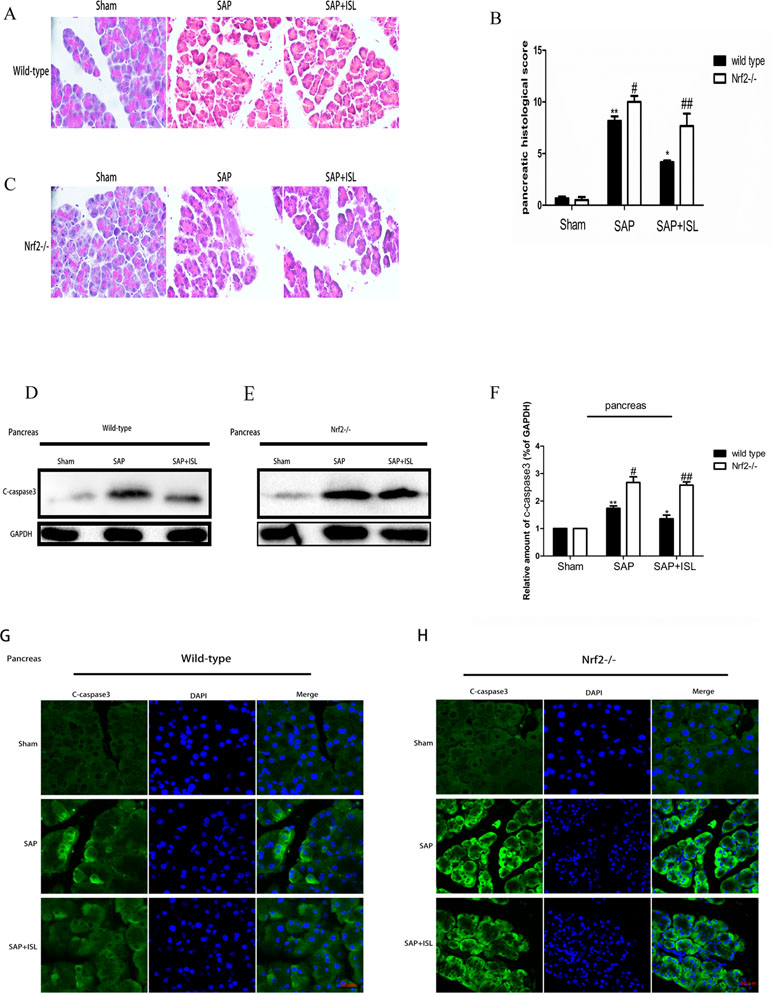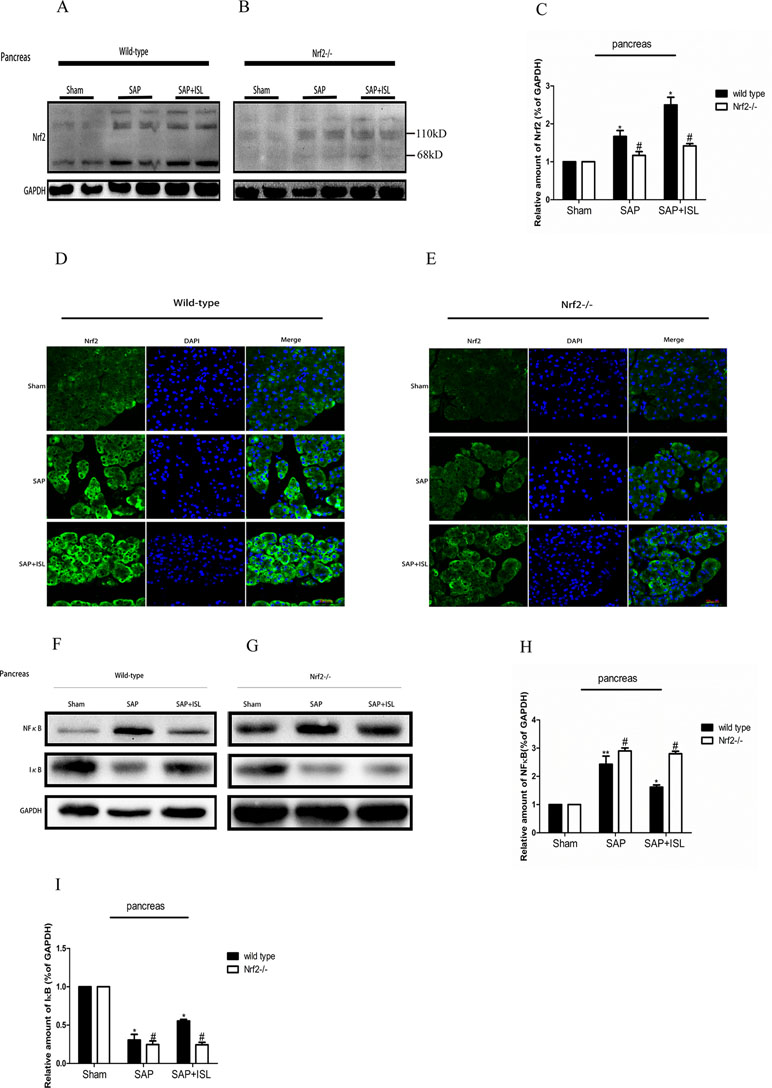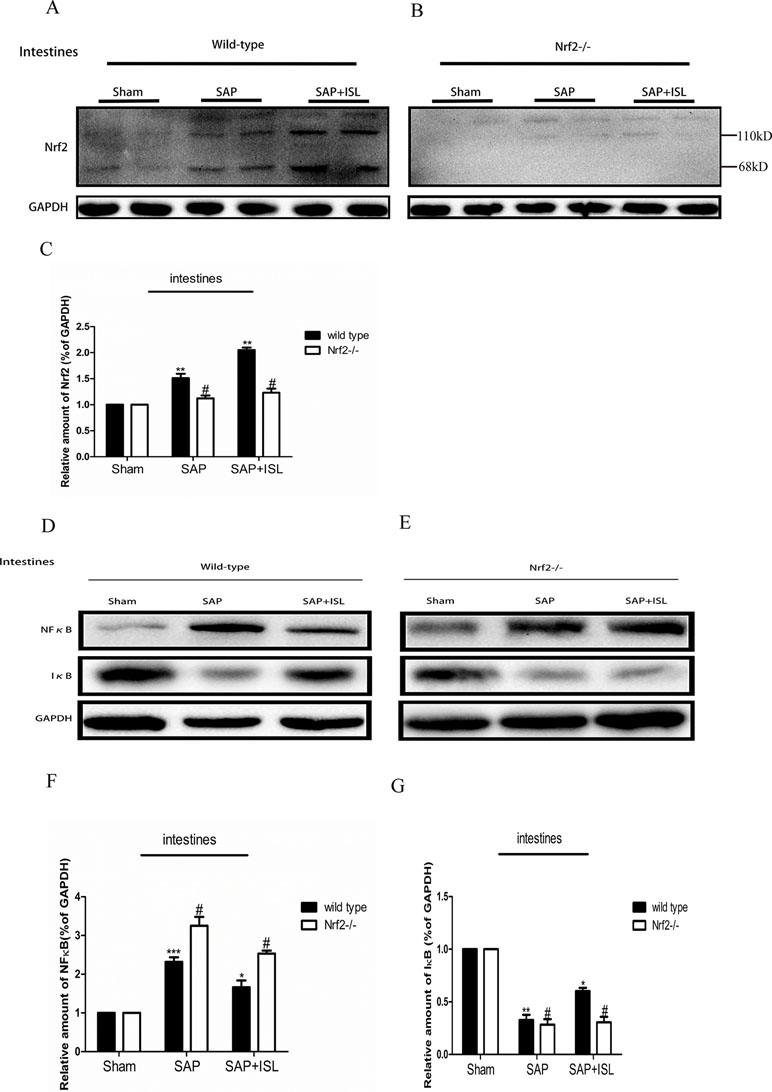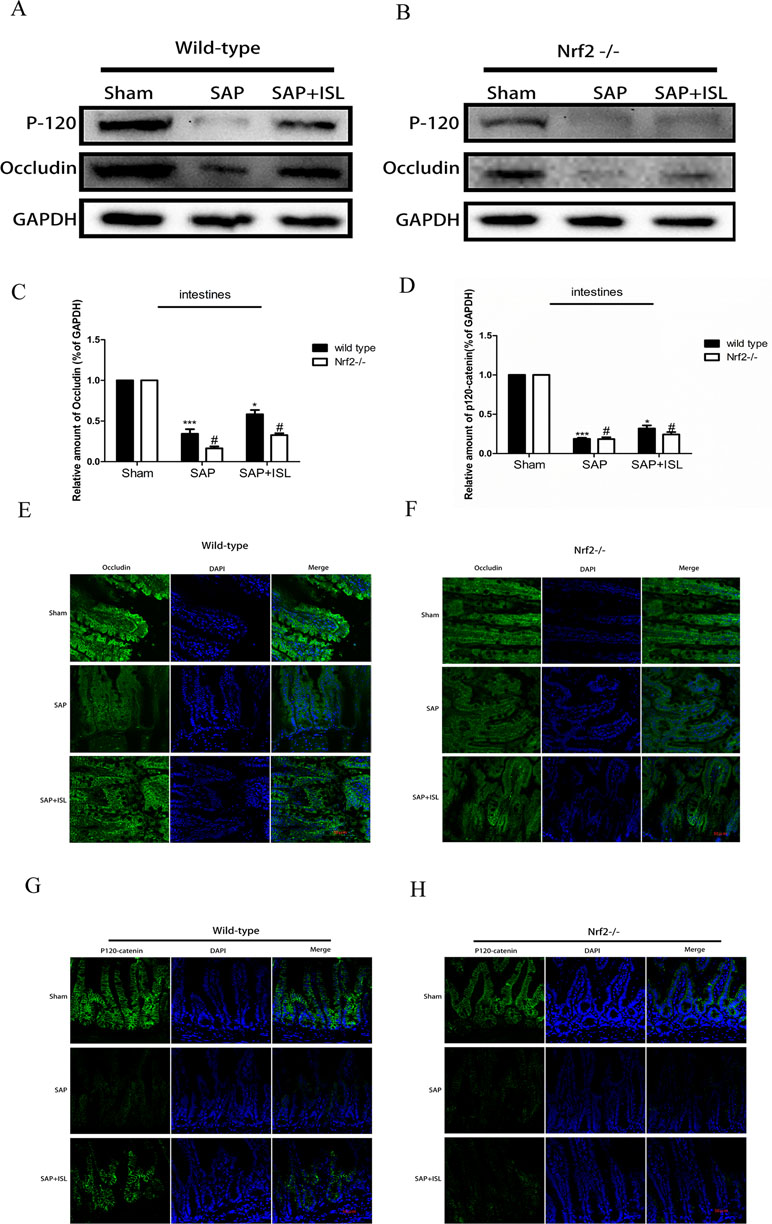- 1Department of Emergency, The Second Affiliated Hospital and Yuying Children’s Hospital of Wenzhou Medical University, Wenzhou Medical University, Wenzhou, China
- 2Molecular Pharmacology Research Center, School of Pharmaceutical Science, Wenzhou Medical University, Wenzhou, China
- 3Wenzhou University College of Life and Environmental Science, Wenzhou, China
A corrigendum on
Isoliquiritigenin Protects Against Pancreatic Injury and Intestinal Dysfunction After Severe Acute Pancreatitis via Nrf2 Signaling
by Zhang M, Wu Y-Q, Xie L, Wu J, Xu K, Xiao J and Chen D-Q (2018). Front. Pharmacol. 9:936. doi: 10.3389/fphar.2018.00936
In the original article, there was a mistake in Figure 1, Figure 4G, Figure 5E and Figure 6E as published. During the process of making substantial amendments to our manuscript, Figures 1G, H were replaced by Figures 4D, E by mistake. In Figure 4G and Figure 5E, the internal reference proteins, GAPDH were incorrect. The Sham group in Figure 6E was selected from another group by mistake. The corrected figures appear below.

Figure 1 Isoliquiritigenin (ISL) treatment protects against combined cerulein plus LPS-induced severe acute pancreatitis (SAP) in pancreatic tissue. (A, C) Pancreatic morphological changes in the different groups at 24 h after SAP. (B) Pancreatic histological scores. (D, E) Expression of c-caspase-3 protein in pancreatic tissue from the different groups at 24 h after SAP. GAPDH was used as the loading control and for band density normalization. (F) Statistical graph of c-caspase-3 proteins. (G, H) Immunofluorescence staining for c-caspase-3 (green) and DAPI (blue) in the different groups. Results are expressed as mean ± SEM. n = 5 per group. *P < 0.05 and **P < 0.01 when comparison was made in WT mice. #P < 0.05 and ##P < 0.01 when comparison was made between WT mice and Nrf2−/− mice.

Figure 4 Effect of ISL treatment on NF-κB and Nrf2 in pancreatic tissue in WT and Nrf2−/− mice after SAP. (A, B) Protein expression of Nrf2 in pancreatic tissue of the different groups after SAP. GAPDH was used as the loading control and for band density normalization. (C) Statistical graph of Nrf2 and GAPDH protein in the different groups. (D, E) Immunofluorescence staining for Nrf2 (green) and DAPI (blue) in the different groups. (F, G) Protein expression of NF-κB and IκB in pancreatic tissue in the different groups after SAP. GAPDH was used as the loading control and for band density normalization. (H, I) Statistical graph of NF-κB, IκB, and GAPDH protein in the different groups. Results are expressed as mean ± SEM. n = 5 per group. *P < 0.05, **P < 0.01, and ***P < 0.001 when comparison was made in WT mice. #P < 0.05 when comparison was made between WT mice and Nrf2−/− mice.

Figure 5 Effect of ISL treatment on NF-κB and Nrf2 in intestinal tissue in WT and Nrf2−/− mice after SAP. (A, B) Protein expression of Nrf2 in intestinal tissue in the different groups after SAP. GAPDH was used as the loading control and for band density normalization. (C) Statistical graph of Nrf2 and GAPDH protein in the different groups. (D, E) Protein expression of NF-κB and IκB in pancreatic tissue in the different groups after SAP. GAPDH was used as the loading control and for band density normalization. (F, G) Statistical graph of NF-κB and IκB. GAPDH protein in the different groups. Results are expressed as mean ± SEM. n = 5 per group. *P < 0.05, **P < 0.01, and ***P < 0.001 when comparison was made in WT mice. #P < 0.05 when comparison was made between WT mice and Nrf2−/− mice.

Figure 6 Effect of Nrf2 deletion on maintenance of intestinal barrier integrity after SAP. (A, B) Protein expression of P-120-catenin and occludin in pancreatic and intestinal tissue in the different groups after SAP. GAPDH was used as the loading control and for band density normalization. (C, D) Statistical graph of P-120-catenin, occludin, and GAPDH protein in the different groups. (E–H) Immunofluorescence staining for P-120-catenin (green), occludin (green), and DAPI (blue) in the different groups. Results are expressed as mean ± SEM. n = 5 per group. *P < 0.05 and ***P < 0.001 when comparison was made in WT mice. #P < 0.05 when comparison was made between WT mice and Nrf2−/− mice.
The authors apologize for this error and state that this does not change the scientific conclusions of the article in any way. The original article has been updated.
Keywords: severe acute pancreatitis, intestinal dysfunction, isoliquiritigenin, Nrf2-/-, NF-κB, oxidative stress
Citation: Zhang M, Wu Y-Q, Xie L, Wu J, Xu K, Xiao J and Chen D-Q (2019) Corrigendum: Isoliquiritigenin Protects Against Pancreatic Injury and Intestinal Dysfunction After Severe Acute Pancreatitis via Nrf2 Signaling. Front. Pharmacol. 10:788. doi: 10.3389/fphar.2019.00788
Received: 03 May 2019; Accepted: 18 June 2019;
Published: 12 July 2019.
Edited by:
Min Ye, Peking University, ChinaCopyright © 2019 Zhang, Wu, Xie, Wu, Xu, Xiao and Chen. This is an open-access article distributed under the terms of the Creative Commons Attribution License (CC BY). The use, distribution or reproduction in other forums is permitted, provided the original author(s) and the copyright owner(s) are credited and that the original publication in this journal is cited, in accordance with accepted academic practice. No use, distribution or reproduction is permitted which does not comply with these terms.
*Correspondence: Da-Qing Chen, Y2RxMTk2NUAxMjYuY29t; Jian Xiao, eGZ4ajIwMDBAMTI2LmNvbQ==
 Man Zhang
Man Zhang Yan-Qing Wu2
Yan-Qing Wu2